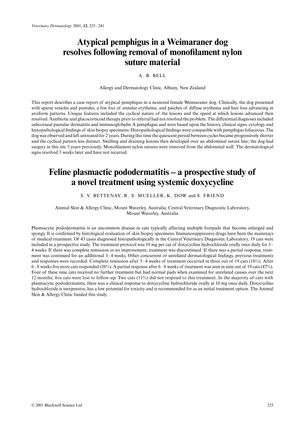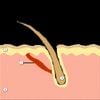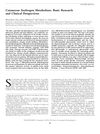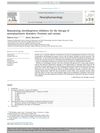American Academy of Veterinary Dermatology and American College of Veterinary Dermatology Annual Meeting, Norfolk, Virginia, April 4-8, 2001
August 2001
in “
Veterinary Dermatology
”
alopecia X trilostane congenital adrenal hyperplasia-like syndrome androgenetic alopecia doxycycline hydrochloride plasmacytic pododermatitis mycophenolate mofetil pemphigus foliaceous erythema multiforme intravenous immunoglobulin selamectin cheyletiellosis pruritus atopic dermatitis IgE eosinophilia Malassezia pachydermatis cutaneous candidiasis alopecia X trilostane congenital adrenal hyperplasia male pattern baldness doxycycline mycophenolate IVIG Revolution itching eczema yeast infection

TLDR The meeting presented findings on effective treatments for various pet skin conditions and insights into the immune responses of dogs with atopic dermatitis.
The document summarizes research presented at the 2001 American Academy of Veterinary Dermatology and American College of Veterinary Dermatology Annual Meeting. Key findings include the resolution of atypical pemphigus in a Weimaraner after removing nylon sutures, the effectiveness of doxycycline hydrochloride in treating plasmacytic pododermatitis in 19 cats, and the potential of mycophenolate mofetil as an adjunctive therapy for pemphigus foliaceous in dogs. A case of severe erythema multiforme in a cat was successfully treated with human intravenous immunoglobulin, and 'alopecia X' in Pomeranians and miniature poodles responded well to trilostane. A study on 15 cats showed selamectin to be an effective treatment for cheyletiellosis, and a novel diet helped control pruritus in 19 food-allergic dogs. Mast cell responsiveness to stem cell factor was higher in 10 dogs with atopic dermatitis compared to controls, and peripheral blood monocytes and B cells in dogs with AD showed more variability and lower IgE-bearing monocytes. Tissue eosinophilia was found to be a differentiator between AD and DFAR in dogs, with a study of 25 dogs showing significant differences in eosinophil counts. Other studies reported no significant immune response difference to Malassezia pachydermatis in atopic versus normal dogs, no significant cross-reactivity in allergen-specific IgE in atopic dogs, successful treatment of cutaneous candidiasis in a dog, and a hormonal basis for congenital adrenal hyperplasia-like syndrome in 51 Pomeranian dogs, with parallels to androgenetic alopecia in humans.





